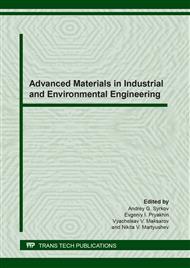[1]
R.K. Nkhoma, C.W. Siyasiya, W.E. Stumpf, Hot workability of AISI 321 and AISI 304 austenitic stainless steels, Journal of Alloys and Compounds 595 (2014) 103-112.
DOI: 10.1016/j.jallcom.2014.01.157
Google Scholar
[2]
V. Moura, A.Y. Kina, S.S.M. Tavares, L.D. Lima, F.B. Mainier, Influence of stabilization heat treatments on microstructure, hardness and intergranular corrosion resistance of the AISI 321 stainless steel, Journal of materials science 43(2) (2008) 536-540.
DOI: 10.1007/s10853-007-1785-5
Google Scholar
[3]
J. Bystrianský, J. Bárta, M. Tvrdý, K. Malaník, Determination of conditions leading to localized corrosion initiation on UNS S32100 (AISI 321) stainless steels in nuclear power plant environments, Nuclear engineering and design 157(1-2) (1995) 123-136.
DOI: 10.1016/0029-5493(95)00989-p
Google Scholar
[4]
B. Raj, U.K. Mudali, Materials development and corrosion problems in nuclear fuel reprocessing plants, Progress in Nuclear Energy 48(4) (2006) 283-313.
DOI: 10.1016/j.pnucene.2005.07.001
Google Scholar
[5]
V.S. Rimkevich, A.A. Sisev, S.V. Muruev, M.V. Blohin, The main directions of improving the traditional technology of smelting stainless steels, Electrometallurgy 1 (2013) 12-17.
Google Scholar
[6]
A.V. Fedosov, A.M. Skrebcov, D.V. Pashchuk, Formation of transverse cracks during the continuous casting of peritectic steels, Metallurgist 1 (2018) 45-54.
DOI: 10.1007/s11015-018-0623-0
Google Scholar
[7]
B.V.R. Raja, Methods of refining stainless steels, Steel Times International 30(4) (2006) 27.
Google Scholar
[8]
V.P. Karasev, S.V. Ryaboshuk, P. V. E. Kovalev, V. Kulikov, Phosphorus removal options at induction melting of steel, Key Engineering Materials 822 (2019) 30-36.
DOI: 10.4028/www.scientific.net/kem.822.30
Google Scholar
[9]
X. Li, Y. Bao, M. Wang, Genetic evolution of inclusions in interstitial-free steel during the cold rolling processes, Transactions of the Indian Institute of Metals 71(5) (2018) 1067-1072.
DOI: 10.1007/s12666-017-1241-4
Google Scholar
[10]
R. Wang, Y. P. Bao, Z. J. Yan, D. Z. Li, Y. Kang, Comparison between the surface defects caused by Al2O3 and TiN inclusions in interstitial-free steel auto sheets, International Journal of Minerals, Metallurgy, and Materials 26(2) (2019) 178-185.
DOI: 10.1007/s12613-019-1722-z
Google Scholar
[11]
Y. Dixin, X. Jingpei, Z. Kefeng, L. Zongfa, W. Aiqin, W. Wenyan, Numerical simulation of stress field in inclusions of large rudder arm steel castings, Research & Development 6(3) (2009) 219-225.
Google Scholar
[12]
P. Kovalev, S. Riaboshuk, A. Issagulov, S. Kvon, V. Kulikov, Improving shipbuilding steel grade quality at stages of smelting, secondary refining, and continuous casting, Metals 9(2) (2009) 2075-4701.
DOI: 10.3390/met9020203
Google Scholar
[13]
P.V. Kovalev, S. D. Popova, A. Z. Issagulov, V. Y. Kulikov, S. S. Kvon, Investigation of the effect of high strength strips steel modification with rare-earth metal (REM), Metallurgical Industry 56(3-4) (2017) 393-395.
Google Scholar
[14]
I.A. Matveev, A.V. Kalmykov, E.N. Bespalov, Compacting as an efficient technique for upgrading the grinding swarf and ensuring environmental safety during its storage, transportation and metallurgical processing, Non-ferrous Metals 5 (2019) 74-80.
DOI: 10.17580/tsm.2019.05.09
Google Scholar
[15]
G.M. Borodulin, Stainless Steel, Metallurgy, Moscow, (1973).
Google Scholar
[16]
W. Liang, R. Wu, Q. Yuan, J. Hu, Investigation on Precipitation Behavior and Morphology of TiN Particles in High-Ti Low-Carbon High-Strength Steel, Transactions of the Indian Institute of Metals (2019) 1-9.
DOI: 10.1007/s12666-019-01816-8
Google Scholar
[17]
L.A. Maltseva, S. Yu. Mitropolskaya, Effect of tensile deformation on austenitic Cr-Ni-steel structure and magnetic properties, Metal Science and Heat Treatment 55(5-6) (2013) 328-334.
DOI: 10.1007/s11041-013-9629-1
Google Scholar
[18]
N.I. Vorob'ev, V.P. Zvonarev, S.P. Palkin, S.V. Borovinskih, A.N. Makarevich, V.I. Melekhov, A. G. Levada, D. A. Livshic, RU Patent 2226555 (2002).
Google Scholar
[19]
A. Ya. Stomahin, E.V. Lysenkova, M. Yu. Kan, A.A. Klachkov, V.A. Kolesnikov, Optimization of adding nitride-forming elements to steel, Ferrous metals 2 (2010) 15-19.
Google Scholar


